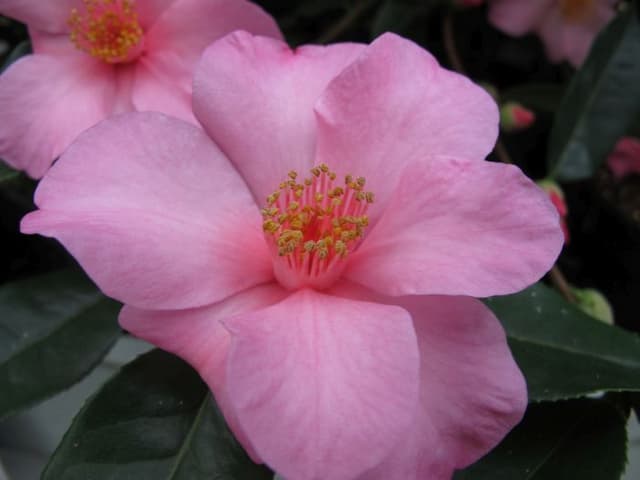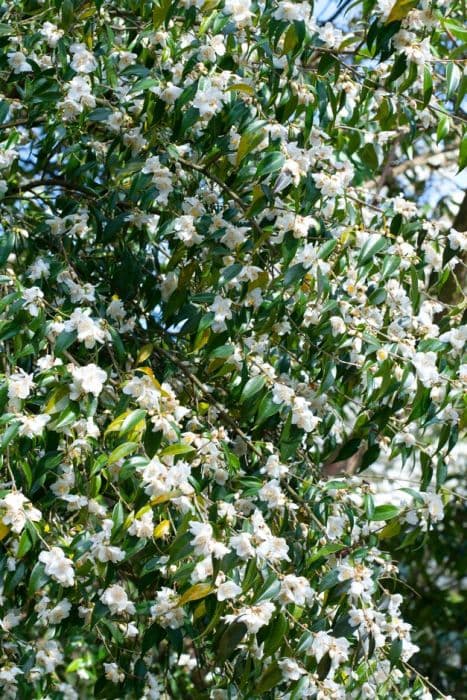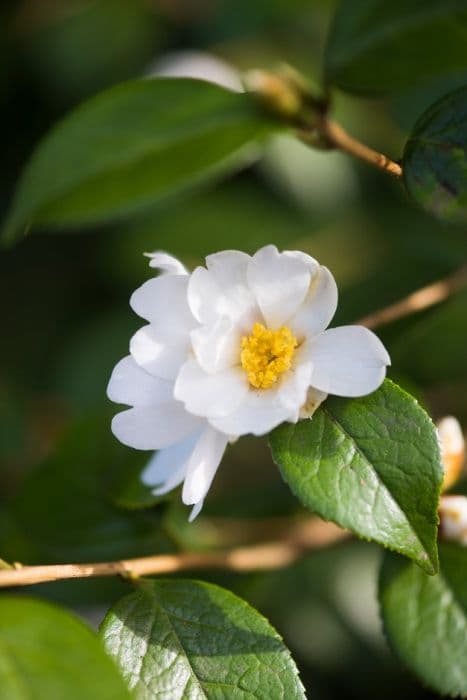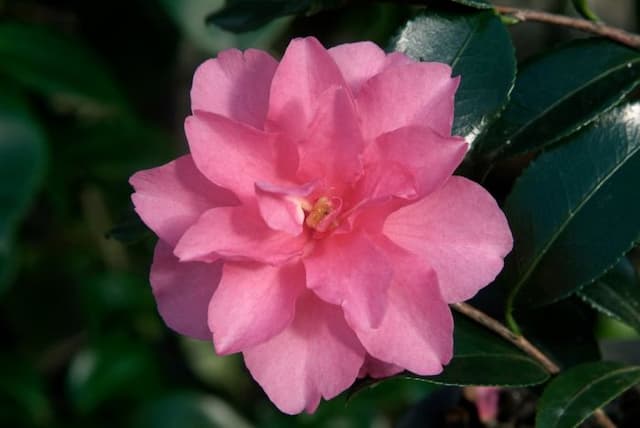Japanese Camellia Camellia japonica 'Moshe Dayan'

ABOUT
Camellia japonica 'Moshe Dayan' is known for its beautiful and showy flowers that make it a popular ornamental plant. This variety of camellia has large, striking blooms that can vary in color. The petals are often a deep pink or red, creating a dramatic contrast against the glossy, dark green foliage. Each flower is composed of multiple layers of petals, giving them a ruffled and full appearance. The foliage of the 'Moshe Dayan' camellia consists of oblong, leathery leaves that have a lustrous sheen. The leaves can grow quite dense, providing a lush, rich backdrop for the flowers. The plant typically has a symmetrical shape with a compact bushy growth habit, creating an attractive silhouette throughout the year. As it blooms, the 'Moshe Dayan' camellia provides a vivid display that can brighten up any garden or landscape. The flowers not only contribute a splash of color but can also attract pollinators such as bees and butterflies. Beyond its aesthetic attributes, this variety of camellia is also known for its resilience and can be quite long-lived with proper care, making it a cherished addition to many gardens for both its beauty and its enduring nature.
About this plant
 Names
NamesSynonyms
Japanese Camellia, Rose of Winter
Common names
Camellia japonica 'Moshe Dayan'.
 Toxicity
ToxicityTo humans
Camellia japonica, commonly known as the Japanese camellia, is not considered toxic to humans. Ingesting parts of this plant typically does not result in poisoning or adverse reactions, and it is generally regarded as safe.
To pets
Japanese camellia is not toxic to pets either. It is not known to cause poisoning if ingested by pets like cats or dogs. However, as with the consumption of any non-food plant material, mild gastrointestinal upset is possible if a pet were to ingest a significant amount of the plant.
 Characteristics
CharacteristicsLife cycle
Perennials
Foliage type
Evergreen
Color of leaves
Green
Flower color
Pink
Height
6-10 feet (1.8-3 meters)
Spread
5-7 feet (1.5-2.1 meters)
Plant type
Shrub
Hardiness zones
7
Native area
Japan
Benefits
 General Benefits
General Benefits- Ornamental Value: Camellia japonica 'Moshe Dayan' is highly valued for its attractive flowers and overall aesthetic appeal, making it a popular choice for gardens and landscapes.
- Long Blooming Season: It has a prolonged flowering period that can last from late winter through spring, providing color and interest during these seasons.
- Drought Tolerance: Once established, it is relatively drought-tolerant, requiring less water than some other ornamental plants.
- Shade Tolerance: This variety can tolerate partial shade, allowing it to be planted in a variety of garden locations.
- Erosion Control: With its evergreen foliage and dense growth habit, Camellia japonica 'Moshe Dayan' can help stabilize soil and prevent erosion.
- Wildlife Attraction: The flowers may attract pollinators such as bees, while the dense foliage can provide shelter for birds.
- Low Maintenance: It generally requires minimal pruning and care once established, making it suitable for gardeners seeking low-maintenance plants.
- Versatility: Can be used in a variety of landscape applications, including as a specimen plant, in foundation plantings, or as part of a mixed shrub border.
 Medical Properties
Medical PropertiesThis plant is not used for medical purposes.
 Air-purifying Qualities
Air-purifying QualitiesThis plant is not specifically known for air purifying qualities.
 Other Uses
Other Uses- Camellia japonica petals can be used to create natural dyes for fabrics, giving textiles a unique and subtle coloring.
- The waxy leaves of the Camellia japonica can be used in floral arrangements to add glossy green foliage that complements brightly colored flowers.
- The smooth, hard seeds of Camellia japonica can be polished and used in jewelry making as beads or pendants for necklaces and bracelets.
- Dried petals of the Camellia japonica can be incorporated into potpourri mixes to add fragrance and color to a room.
- Pressed Camellia japonica flowers can be used in crafting, such as homemade cards or bookmarks, for a touch of natural beauty.
- Camellia japonica branches can be used as natural stakes to support other plants in gardens, being both functional and aesthetically pleasing.
- Fallen Camellia japonica blossoms can be scattered in paths or on water features for a romantic, ephemeral decoration that changes with time.
- When trimmed appropriately, Camellia japonica branches can be used in the art of bonsai for creating miniature, sculpted trees.
- The wood of the Camellia japonica plant, being hard and finely grained, can be used to craft small wooden items or turned objects on a lathe.
- Camellia japonica leaves can serve as a natural mulch, providing soil with nutrients as they decompose, while also deterring weed growth.
Interesting Facts
 Feng Shui
Feng ShuiThe Camellia is not used in Feng Shui practice.
 Zodiac Sign Compitability
Zodiac Sign CompitabilityThe Camellia is not used in astrology practice.
 Plant Symbolism
Plant Symbolism- Adoration: Camellias often symbolize deep adoration and affection, making them a suitable gift for a loved one to whom one wishes to show unwavering attention and respect.
- Perfection and Excellence: The perfect form and stunning beauty of the camellia blossom represent aspiration towards perfection and excellence in many cultures.
- Admiration: Camellias can express the sentiment of secret admiration, especially when given as a gift to someone who is deeply respected and appreciated.
- Longevity and Faithful Love: As camellias are evergreen plants with a long blooming period, they can symbolize the enduring nature of love, suggesting a commitment that will stand the test of time.
- Divine: In some eastern cultures, particularly Japan, camellias are considered divine and are often associated with gods and sacred entities, signifying spiritual purity.
 Water
WaterCamellia japonica, commonly known as the Japanese camellia, prefers consistently moist but well-draining soil. It should be watered deeply when the top inch of soil feels dry to the touch, which often equates to watering once a week. However, the frequency may increase to 2-3 times per week during dry spells or hot weather. A good approach is to apply at least two gallons of water for mature plants at each watering, ensuring the entire root zone is moistened. It's vital to avoid over-watering, which can lead to root rot.
 Light
LightJapanese camellias flourish best in partial shade, receiving a few hours of morning sun with protection from the intense afternoon rays. An ideal spot for Camellia japonica is an east-facing location that benefits from the soft morning light and prevents the harsh afternoon sun, which can scorch the foliage and flowers.
 Temperature
TemperatureThe Japanese camellia thrives in temperate conditions and can typically handle temperatures as low as 20°F without damage, while they prefer a range between 34°F and 60°F for optimal growth. Camellia japonica can endure short periods of colder temperatures, but it's important to protect it from frost to prevent damage to the blossoms and foliage.
 Pruning
PruningPrune Japanese camellias immediately after they finish blooming to maintain shape and remove any dead or weak branches, which encourages fuller growth and better blooming the following season. Light pruning should be done annually, and more extensive reshaping should be undertaken every few years if necessary, always being mindful to leave sufficient leaves for continuous growth.
 Cleaning
CleaningAs needed
 Soil
SoilThe Japanese Camellia (Camellia japonica 'Moshe Dayan') thrives best in a well-draining, acidic soil mix with a pH between 5.5 and 6.5. The ideal soil mix for this camellia should include organic components such as peat moss, pine bark, and perlite to ensure good aeration and moisture retention without waterlogging. Regularly check soil pH and adjust with sulfur or peat if it becomes too alkaline.
 Repotting
RepottingJapanese Camellias should be repotted every 2-3 years to prevent root-bound conditions and replenish nutrients in the soil. It is best to repot in the spring just before the growing season begins. Over time as the plant matures, the frequency of repotting can decrease, but it is important to monitor the soil condition and root growth.
 Humidity & Misting
Humidity & MistingJapanese Camellias prefer moderate to high humidity levels, ideally between 40% and 60%. These conditions can be met in a garden environment with mulching and shading or indoors by placing a humidity tray under the pot or using a room humidifier. Maintaining proper humidity is critical for flowering and overall plant health.
 Suitable locations
Suitable locationsIndoor
Ensure bright, indirect light and high humidity for indoor Camellia japonica.
Outdoor
Plant in part shade, sheltered, with moist, acidic soil for outdoor Camellias.
Hardiness zone
7-9 USDA
 Life cycle
Life cycleCamellia japonica 'Moshe Dayan', commonly known as Japanese Camellia, begins its life as a seed, which upon germination in favorable conditions of moist, well-drained acidic soil, and partial shade, emerges as a seedling. As the seedling grows, it develops into a young plant with glossy, evergreen leaves and begins to establish a sturdy root system. Progressing into maturity, the shrub produces buds in the late summer to autumn which will overwinter and blossom into large, showy flowers in late winter to spring. After pollination, typically by insects, the flowers develop into dry seed capsules that eventually open to release seeds for the next generation. Throughout its life, Japanese Camellia undergoes seasonal growth spurts and periods of dormancy, usually in response to temperature and light changes. With proper care, this evergreen can live for many years, often several decades, as it continues to mature and produce flowers annually.
 Propogation
PropogationPropogation time
Spring-Early Summer
The most common method of propagating Camellia japonica 'Moshe Dayan', commonly known as the Japanese Camellia, is through semi-hardwood cuttings. This process typically takes place during the late summer. To propagate, a stem cutting of about 4 to 6 inches (10 to 15 centimeters) long is taken from a healthy parent plant. The lower leaves are removed, and the cut end is dipped in rooting hormone to increase the chances of successful rooting. The cutting is then inserted into a pot filled with a mix of peat and perlite to provide aeration and moisture retention. The pot is placed in a warm, shaded area and kept consistently moist. With proper care, roots should develop within a few weeks, after which the new plant can gradually acclimate to more sunlight and eventually be transplanted.









